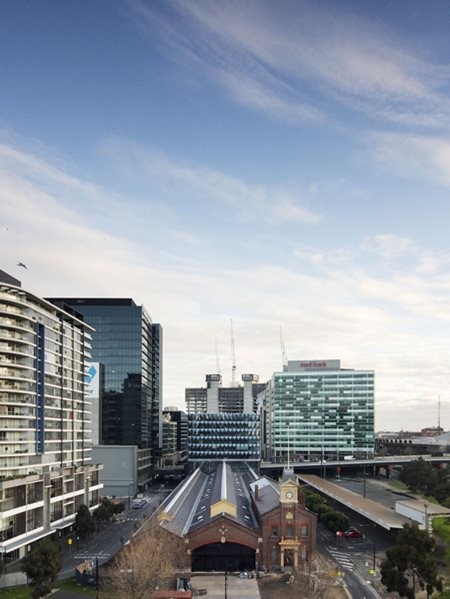Rising out of Melbourne’s historic Docklands precinct is a unique glass facetted building from Building Studio Architects that adopts manufacturing innovations to deliver on an imaginative client brief.
The ‘Lantern’ as it is now known, sits five stories high on 7,500sqm of tenancy at the entrance to the fully refurbished 1880s Goods Shed South on Collins Street, Melbourne and forms part of the $1.6bn Collins Square Project.
The name Lantern certainly wasn’t an afterthought. Christian Cooksley from Building Studio says that the client brief requested this profile specifically and the project’s unique polyhedron glass façade arrangement was his team’s contribution to this vision.
“The client came to Building Studio with a remarkable opportunity – to imagine a building that could act as a ‘lantern’ or ‘beacon’ for the people of Melbourne: forming the entry to the historic Goods Shed South,” said Cooksley.
“Drawing upon the ‘Lantern’ concept, we drew upon the materiality of objects such as cut crystal, precious gem stones and the glass lenses found in lighthouses. We wanted to emulate the way these objects capture and refract light, but achieve this on a larger, urban scale.”

^"In fulfilling key brief requirements, the Lantern evolved into an elevated faceted jewel whilst sensitively incorporating the rich cultural history embodied in the Goods Shed beyond. The raised entry and colonnade reinforces a prominent Collins Street address, with clear glazing ensuring public views of the Goods Shed’s intricate truss framing and roof," - Christian Cooksley from Building Studio. Image: Ben Hosking
What resulted is a unitised prefabricated glass panel façade that is formed in a series of rectangular pyramids of low- e coated double glazed units.
The panels were crafted overseas by China Southern Glass but Cooksley said the individual housing brackets for the polyhedrons were bought from Australian retailers and were made on-site.
“During manufacture [of the glass panels] off-the-shelf curtain wall sections were formed into a rectangular pyramid utilising a bespoke cruciform bracket concealed within the extrusion to secure the apex.”
Cooksley chose this method of construction as it eliminates bespoke testing and was the most economically sound.
“While unique in its appearance, by employing standard, typical curtain wall technology panels could be manufactured economically offshore, efficiently transported and rapidly installed on site. This approach also ensured the façade could be constructed and installed without the need for bespoke testing or certification that would have added cost or delay to a tight commercial delivery programme,” he said.

^Image: Ben Hosking
This system is not without its challenges and Cooksley admitted a lot of design hours went into getting the panel design suitable for offsite manufacturing and the building shell ready for the façade’s arrival.
“Although the panels’ detailed design required variable geometries to be accommodated, manufacturing costs were minimised by utilising off-the-shelf aluminium extrusions,” he said.
He also explained that the the three dimensional form of each panel amplified the offshore transportation overheads by significantly reducing the number of panels that would fit in a shipping container.
“Building Studio resolved these transport problems by working with the manufacturer to re-engineer the transport stillage to maximise panels per shipping container module,” explained Cooksley.

^“Aside from the unique façade system, adaptive reuse of the heritage Goods Shed was sensitively achieved via the insertion of a suspended steel mezzanine level floor, penetrated by generous voids, the underside left exposed to reference the building’s industrial past. Services were carefully co-ordinated to ensure a clean yet logical and orderly aesthetic,” - Christian Cooksley from Building Studio. Image: Shannon McGrath
Another important part of the brief was to provide a key landmark on the journey from Melbourne’s historic CBD into the Docklands precinct beyond—one that Cooksley highlighted as a challenge.
“The site presented many urban challenges, not least the low-lying heritage building which created a distinctive gap in Dockland’s urban fabric. This called for a design response capable of mediating the relationship between the Goods Shed and the adjacent modern high-rise towers,” he said.

^Image: Ben Hosking
Cooksley was confident however that his team met the brief and established a landmark building that mediated the old and the new:
“The junction between old and new, experienced via an articulated atrium leading to the building’s lower levels, offers the opportunity to encounter the Goods Shed’s fabric up close. The atrium is carefully detailed to provide the lightest possible touch and allow seamless connection of historic and modern,” he said.
Another key concept from the building is its five and 4.5 Green Star and star Nabers ratings which derives more from the architects finesse than the technological features of the building.
“A key design concept enhancing environmental performance was to locate the building’s service cores to the eastern and western extremities of the floor plate, limiting solar load and enabling a comfortable internal environment to be achieved without complex active systems or external shading,” said Cooksley.
“All tower floors feature naturally lit, open, flexible workspaces that maximise views and planning opportunity. Chilled beam technology and Dali control to light fittings were installed throughout the commercial spaces.”
The lantern is shortlisted for the Victorian Architecture Awards, hosted by the Australian Institute of Architects. The winners for the awards will be announced 20 June and will then go on to compete at the national awards later in November.

